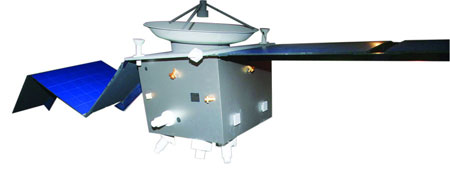 China's first Mars probe will be launched atop a Russian launch vehicle in October 2009, a senior scientist has said.
China's first Mars probe will be launched atop a Russian launch vehicle in October 2009, a senior scientist has said.Yinghuo-1 will reach the preset circling orbit and send back the first images of the red planet in September 2010, said Chen Changya, a researcher with the Shanghai Institute of Satellite Engineering.
The micro-satellite will lead the country one big step further in its deep space exploration.
The probe's prototype is now being subject to a series of experiments, and next May, its compatibility with the Russian spacecraft will be tested, Chen - who is in charge of the project developing the Mars probe - told a forum on aerospace technology in Shanghai on Sunday.
He said that the probe will travel 350 million km in 11 months before entering planet's orbit.
In comparison, lunar orbiter Chang'e I traveled 380,000 km before circling around the moon. The distance between Mars and Earth is between 56.7 million km and 400 million km, depending on their orbital positions.
The 110-kg Mars probe will circle around the planet for one year, though it has a designed life of two years.
It will conduct scientific exploration tasks, including exploring the Martian space environment, and relay back the first Mars images taken by a Chinese satellite, Chen said.
An official with the Shanghai Aerospace Bureau, surnamed Zhen, confirmed the Mars project but added that the probe's final name has yet to be decided.
The mission is the result of close cooperation with Russia, and represents a "milestone" in the history of space cooperation between the two neighbors, the China National Space Administration (CNSA) said in a statement in March.
Earlier reports said the probe would be launched along with "Phobos Explorer", a Russian spacecraft, atop a Russian rocket.


After entering Mars' orbit, Yinghuo-1 will be detached from the Russian spacecraft, which will land on the Martian moon and return to Earth with soil samples.


In 1964, the United States' fly-by Mariner 4 sent back 21 images of Mars, the first successful exploration of the planet in human history. In 1971, the former Soviet Union's Mars 3 orbiter sent back data for eight months.
NASA's twin robot geologists, the Mars Exploration Rovers, launched on June 10 and July 7, 2003, landed on Mars on January 3 and January 24, to search for and characterize a wide range of rocks and soils that hold clues to past water activity on Mars.






No comments:
Post a Comment